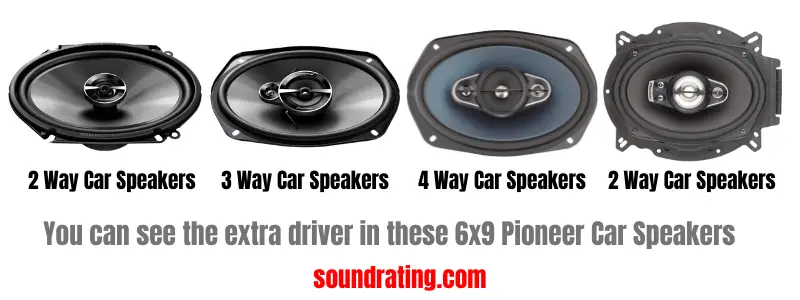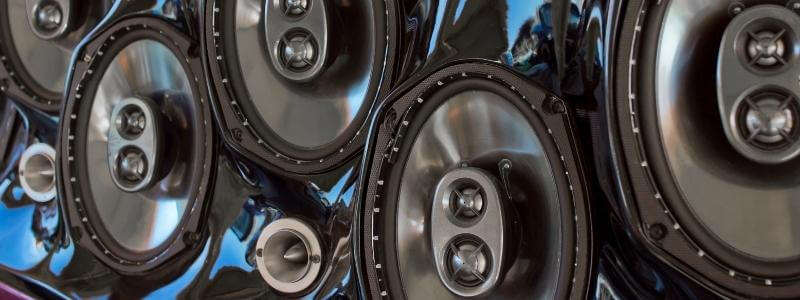2-Way, 3-Way, 4-Way and 5-Way Speakers… What’s The Difference?
Ever wondered what the difference is with a 2-way vs 3-way speakers? They are the most common aftermarket speakers, but you can get 4- and 5-way speakers for your car stereo system, as well.
Firstly, whether you get 2-way or 5-way, all aftermarket speakers will make a huge difference to the sound your stereo system makes.
That’s because factory speakers are limited, as car manufacturers want to keep costs down. So getting some aftermarket speakers, no matter what range, will ensure your listening experience is richer.
But what’s the difference and what effect does it have on my listening experience whether I get a 2-, 3-, 4-, or 5-way speakers? Read on for an explanation of the basics and differences and then you can make a more informed decision on which range speakers you should get for your car.
Speaker Basics
The term 2-way to 5-way determines how many different drivers the speakers have inbuilt. And each separate speaker built in works on different frequencies, and the more speakers the narrower the frequency it has to work with.
Different speakers can handle the lows, mids and highs, no matter how many drivers are built into it. Of course if you want the really low bassline, you need to get a separate subwoofer for your car.
All speakers have at least two drivers in them: a woofer and a tweeter. As you go up in range, the more drivers the speakers have but the standard is the woofer and tweeter.
Many people believe that the more drivers in a speaker means it must have the best sound, but this isn’t necessarily true. If it was, surely 5-way speakers would be the best sellers, no?
Sure, the more drivers in a speaker allows each separate driver to work on a shorter frequency range. But it’s more to do with the speaker material quality, the crossover, and the components that determines the sound quality.
Remember, each driver is more expense for the manufacturer. So, a 2-way speaker that costs nearly as much as a 4- or 5-way speaker will either sound better, or last much longer because the materials and components used will be better.

What Are The Drivers Found In A Speaker?
As mentioned, there are 2 main drivers found in a speaker: the woofer and tweeter and these can handle the full range of frequencies. That’s right, a woofer can reach the lows that a subwoofer can, but it’s not specialised and it has to work on a much wider frequency, so the bass won’t be as clear as a subwoofer.
In other more complex speakers there are other drivers, so the woofer and tweeter don’t have to handle the full range of frequency on their own.
The Woofer is the main driver that produces the lower and midrange frequencies. They’re the biggest driver you see in a speaker and these consume more power than other drivers in the speaker.
The Tweeter is the driver that takes care of the high frequencies. These are usually about 1 inch and protrude from the middle of your woofer, or are a separate driver altogether with component speakers.
The woofer and tweeter can be found in every speaker set, and are essential for good quality soundscape.
As well as a woofer and tweeter, 3-way speakers have what is known as a mid-range driver. As the name suggests mid-range looks after the mid-range frequencies.
Mid-range speakers are usually smaller than woofers, and these will take the weight off a woofer and look after the mids allowing the woofer to concentrate more on the lower frequencies.
Because of the extra driver the sound can be more distinct if you get good quality 3-way speakers. And if you are willing to invest a bit more cash and get some good quality 3-way speakers the mid-range can really make your soundstage more immersive.
4-way speakers usually have the same driver components in a 3-way: a woofer, mid-range, and a tweeter, and because it’s a 4-way, yes you’ve guessed it, they have another driver.
As well as these 3 drivers, 4-way speakers also have what’s known as a super tweeter, which as the name suggests is like a tweeter, but erm super. Well, they’re not really super, but these tiny little drivers do work on the even higher frequencies than tweeters, allowing your tweeter to concentrate on a narrower range.
5-way speakers aren’t that common, but you can get them for your car stereo. As you’ve guessed it, they include the four drivers you get in a 4-way speaker and usually there’ll be a mid-woofer.
A mid-woofer allows your woofer and mid-range drivers to concentrate on an even narrower range, which should result in even more pronounced soundscape.
Surely More Drivers Means a Better Sound?
While you might think a speaker with more drivers in it has to sound better, this isn’t necessarily true.
Don’t get me wrong, there are some fantastic 5-way speakers, but 2-way speakers can also reproduce a good quality soundstage. And if you have them as part of a full aftermarket set up with an amplifier and subwoofer, you can make a major difference to the high fidelity in your car.
The main problem with having more drivers is that your crossovers will have to work harder. A crossover is a component that filters sound frequencies into different bands. It then splits into however many drivers and channels them into each one.
So making sure you get good quality crossovers that can handle your set up is critical, especially if you go for more drivers. These can be bought separately, or they come with a speaker set up, but make sure you invest in good quality equipment if you want the fuller sound.

Is It Really Worth Getting Speakers With Multiple Drivers?
Many people think that speakers with extra drivers have to sound better, but as we now know this isn’t always true. It really depends on the materials your speaker sets are made with.
As already mentioned, the crossover is critical, and it has to be excellent quality, especially if you’re going for full range speakers.
A speaker with more drivers doesn’t mean better sound. A 2-way could easily produce a better-quality sounds than a full range speaker, especially if they’re in a similar price range.
The 2-way speaker might have to work on wider frequencies, but a full range speaker that can concentrate on narrower frequencies will be futile if the materials are cheaper.
Remember, the more components, the more expensive your car speakers should be. So, if it doesn’t cost much more than a 2-way speaker the materials will likely be inferior, too.
A good quality 2-way speaker will definitely be better than one with more drivers but in a similar price range.
A 3-, 4- or 5-way speaker only really makes sense if you are using top notch components. If you are willing to invest a nice chunk of money, the mid-range component will definitely make for a more mesmeric sound quality.
Personally, I like 3-way speakers, but I’m really into audio and creating the best soundscape possible. I don’t think you need more than a 3-way speaker, although some people beg to differ, but again: if you’re not willing to spend a fair bit more, then stick with a good quality 2-way speaker.

I am a passionate and skilled car audio enthusiast with 15 years of experience in the industry. My journey started when I replaced my first set of factory car speakers, sparking a deep love for high-quality sound. Since then, I have worked as a representative for renowned brands like Kenwood and Alpine.
With a background in both retail and distribution, I have developed a comprehensive understanding of the car audio market. Currently a certified (MECP) installer in the Mobile Electronics industry, my expertise lies in delivering top-notch audio installations. My knowledge, coupled with my genuine passion, makes me the go-to professional for all car audio needs.

